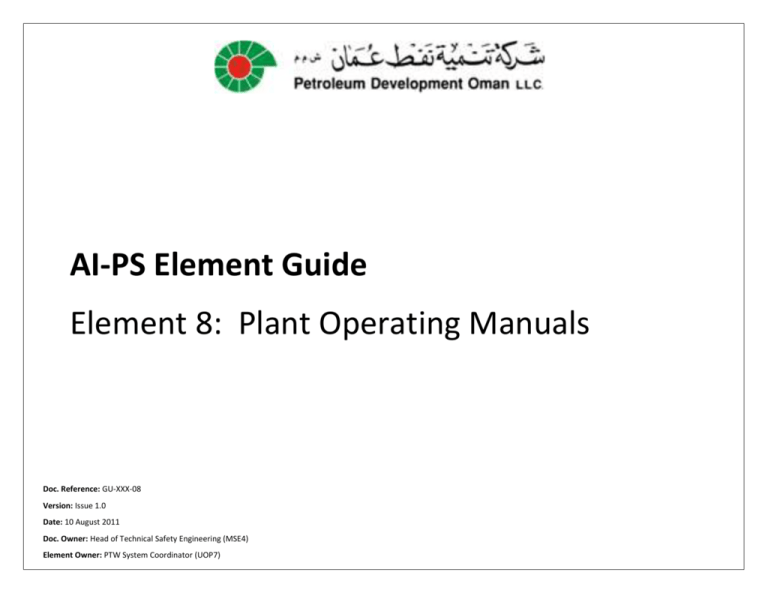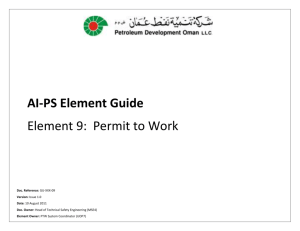AI-PS Element Guide No 8
advertisement

AI-PS Element Guide Element 8: Plant Operating Manuals Doc. Reference: GU-XXX-08 Version: Issue 1.0 Date: 10 August 2011 Doc. Owner: Head of Technical Safety Engineering (MSE4) Element Owner: PTW System Coordinator (UOP7) AI-PS Element Background There are 20 elements in total within the PDO AI-PS Management System as follows: AI-PS in PDO Elements list: Assuring the safety of our people, our assets, the environment and the company’s reputation is a core value of PDO and providing assurance that we are managing our major process safety risks is a critical aspect of our corporate governance. Asset Integrity Process Safety (AI-PS) describes the way we manage our assets so that the process risk is As Low As Reasonably Practicable (ALARP). What it is Asset Integrity Process Safety (AI-PS) is the means of ensuring that the people, systems, processes and resources, which deliver integrity, are in place, in use and fit for purpose throughout the whole lifecycle of the asset. The aim is to be able to confidently state that ‘our assets are safe and we know it’. Asset Integrity Process Safety Management is a complex area of expertise covering a wide range of components, all of which are essential to ensuring systems, processes and equipment perform as required. There are a number of Elements which make up the Asset Integrity Process Safety management system. Structure of AI-PS Assurance in PDO PDO has a three-tiered approach to AI-PS assurance: Level 1: Includes audits conducted on behalf of PDO's Internal Audit Committee (IAC) as part of the Integrated Audit Plan. This includes independent audits carried out by external bodies, such as Shell. Level 2: Includes audits carried out on behalf of Asset Managers as part of their own Asset level assurance processes. Level 3: Includes task verification and assurance activities that supplement the formal audit process. Element 1: Process Safety Culture Element 2: Compliance with Standards Element 3: Corporate Process Safety Competency Element 4: Workplace Involvement Element 5: Stakeholder Outreach Element 6: Process Knowledge Management Element 7: HEMP Element 8: Plant Operating Manuals Element 9: PTW Element 10: Technical Integrity Element 11: Contractor Management Element 12: Training and Performance Assurance Element 13: Management of Change Element 14: Readiness for Start Up Element 15: Conduct of Operations Element 16: Emergency Management Element 17: Incident Management Element 18: Measurements and Metrics Element 19: Audit and Verification of Level 2 Process Element 20: Management Review and Continuous Improvement Element 8: Plant Operating Manuals Background to Element High levels of human performance are critical to achieve process safety excellence. Up to date, clear and unambiguous operating procedures provide a method of reducing the risk to the operator and the plant and ensuring that the facility is operated consistently using intended and proven methods. Plant Operating Manuals (POMs) must therefore be controlled to ensure they are up to date at all times. Procedural control is conducted throughout the lifecycle of the facility - from its inception to decommissioning. The intended audience for the guide are the members of the AI-PS Assurance Leadership Team (AIPSALT) although this can be used as a basis for training and awareness for all staff at the asset. Aims and Objectives of Element Responsibilities and Accountabilities for AI-PS Element Guide Implementation The aim of this element is to ensure that the facility operating procedures meet the requirements and needs of the business. The objective of this element is to ensure that through a Level 2 and Level 3 audit process the facility operating procedures are being controlled with regards to: Preparation; Production; Review; Approval; Compliance; Amendments following user comments; Amendments following modification to the facility; Amendments following changes to legislation. Scope of Element The scope of this element applies to all PDO asset areas within Production Operations during all phases of the facility lifecycle. AI-PS Element Guide Implementation The Operations Manager is accountable for the Level 2 Assurance process at the asset. Completion of the Level 2 Self Assessment and Level 3 Verification Checklists, as provided in this element guide, is the responsibility of the Element Champions and AIPSALT. The Delivery Team Leader (DTL) is accountable for the AIPSALT. AI-PS Assurance Leadership Team (AIPSALT) The AIPSALT is comprised of the asset DTL and Process Safety Element Champions (PSEC). The DTL and PSEC roles include: reporting the status of the Level 3 Verification activities for the relevant Element at the AIPSALT meeting; maintaining Key Performance Indicators (KPIs) for the Element; monitoring the effectiveness of the Level 3 Verification activities in assuring AI-PS, and recommending changes to improve effectiveness and efficiency as appropriate; monitoring the progress of corrective actions and improvement plans associated with that Element; and leading Level 2 Self-Assessment of compliance with the requirements of that Element. Aims and Objectives of AI-PS Element Guide The aim of this AI-PS Element Guide is to provide background to AIPS and a structured and consistent approach to carrying out Level 2 Self Assessments and Level 3 Verification for all AI-PS Elements within PDO. Level 2 Assurance Level 2 Self Assessment and Audit Level 2 assurance is provided by a series of AI-PS audits carried out on behalf of Asset Directors and Operations Managers as part of their own Directorate-Level assurance processes. Level 2 Audits (and Level 2 Self Assessments) are conducted at each Directorate using standard protocols and templates described in this series of AI-PS Element Guides. The Level 2 Self Assessment Checklist (provided in this AI-PS Element Guide) can be viewed as a ‘health check’ of asset performance again the element. Completing the Level 2 Self Assessment will help the asset to identify areas for improvement ahead of the Level 2 Audit. Frequency of Level 2 Assurance Level 2 Audits are conducted annually at each Directorate but the frequency and duration may be adjusted to reflect either positive or negative trends, recent audit findings, emerging risks and alignment with other audit activities. The schedule of Level 2 audits is set in the Directorate HSE Plan. The frequency of Level 2 Self Assessment should also reflect how well the asset is performing against all AI-PS Elements and be performed no less than on an annual basis (ahead of the Level 2 Audit). Level 3 Verification Checklist Level 3 Verification Description Level 3 Verification demonstrates compliance with the asset HSE Case ‘barriers’, HSE Critical Tasks, operational procedures and other requirements defined in the HSE Management System. These activities provide an ongoing check that the procedures, tests and inspections necessary to maintaining the functionality of Safety Critical Elements and systems are completed as required so that process risk is managed to a level that is As Low As Reasonably Practicable (ALARP). In summary, the Level 3 Checklists are an operational level sample check or ‘mini audit’ completed by the asset against PDO and asset based procedures. The effectiveness of the Level 3 Verification process is assessed during the Level 2 Self Assessment process and ultimately via the Level 2 Audit programme. Verification Checklists Level 3 Verification checklists have been developed for each AI-PS Element within PDO in order to provide a structured and consistent approach to Level 3 Verification across all assets. The Level 3 Verification checklists are structured as a sample check or specific and localised audit of the Element in question. By successfully verifying that the Level 3 Verification activities are being completed correctly it provides a strong indication that the element is being implemented at the ’system level’ (assessed via the Level 2 Self Assessment and Level 2 Audits). The Level 2 Self Assessment and Level 3 Verification checklists for this element are provided below. Level 2 Self Assessment SN Protocol 8.1 Does the latest version of the Plant Operating Manual reflect the current utilities & process equipment and operating conditions of the facility? Are operators involved in the production of the Plant Operating Manual? Ask operations and asset process engineering staff. Do operations staff have access to the latest version of the Plant Operating Manual? Does the latest version of the Plant Operating Manual meet the content requirements of SP-1074? Witness process for accessing procedures. 8.2 8.3 8.4 8.5 8.6 8.7 Has there been a requirement to use the step-out approval process for the Plant Operating Manuals in the last twelve months? Draft Plant Operating Manuals are used for training on new stations. Are the changes that are made to the procedures, following commissioning, communicated to the operators? Has the Plant Operating Manual been reviewed in the last three years, in accordance with PR-1052? Y / N / NA & evidence Possible approaches Ask the operators. Does the POM contain adequate sections on: Philosophies Safety Process Description Normal Operating Conditions Alarms & Trips Plant Control & Logging Shutdown Utility Systems Consumables First-Line Maintenance Reference Drawings Review Operating Procedures for general condition Review step-out justification and form an opinion of its adequacy. Ask the operator. Review training records. SN Protocol 8.8 Have all permanent changes to the Plant Operating Manuals been forwarded to the custodian? 8.9 Have all relevant, permanent changes been incorporated in the current version of the Plant Operating Manual? Are Plant Operating Manual Level 3 Verification checks carried out in line with the asset’s defined schedule? 8.10 Y / N / NA & evidence Possible approaches Confirm POM is current and that any changes are subject to a MoC process. Check Level 3 Verification schedule. Review completed checklists. Review minutes of AIPSALT for improvement actions. AI-PS Level 3 Plant Operating Manual (POM) Verification Checklist Asset ________________________________________________________________ Name (Interviewee) _________________________________ Date ___________ Contractor / Ref. ID. ___________________ Plant Operating Manual (Doc. No. & Rev.) ______________ Yes 1) Plant Operating Manual use Are operators using the latest approved version of the POM? Are hard copies of the POM kept at key locations i.e. control rooms, MAF, LECC? Is the location of each hard copy recorded? Do the hard copies contain all the latest updates to the POM? Are the hard copies fit for purpose? Are all hard copies authorised? Have all previous versions been removed? 2) Plant Operating Manual update/amendment For a section of the POM (e.g. start-up; normal operating conditions, alarms & trips, shutdown; etc.), check the following: a) Have operators made amendments to the operating procedures to reflect the true status of the plant? b) Where the operator has made amendments have these been recorded? c) Where the operator has made changes to parameters (alarms, trips, set points, consumable levels) have these been risk assessed and recorded? d) Where the operator has made changes have these changes been annotated to all authorised copies of the POMs? e) Have all proposed changes been assessed and verified by the production supervisor prior to inclusion in the POM? Is there a master set-point/instrument register for the facility? Have all operators undergone a period of training for the introduction of new facilities/modification to existing plant? No Remarks Auditor overall comments Auditor Name________________ Signature _______________ Indicator ________________ Date _____________






